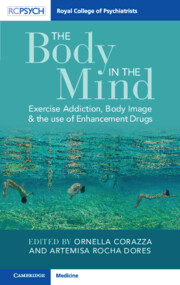Book contents
- The Body in the Mind
- The Body in the Mind
- Copyright page
- Dedication
- Contents
- Figures
- Tables
- Boxes
- Contributors
- Acknowledgements
- Introduction
- Section 1 From Exercise to Addiction: An Introduction to the Phenomenon
- Chapter 1 Exercise Addiction
- Chapter 2 From Exercise to Addiction
- Chapter 3 The COVID-19 Pandemic
- Chapter 4 Excessive Exercise and Image- and Performance-Enhancing Drug Use Among Sports Disciplines, and the Role of Mind–Body Training
- Chapter 5 The Ideal of the Perfect Body
- Chapter 6 Exercise, Fitspiration, and the Role of Social Media
- Chapter 7 Eating Disorders and Over-Exercise
- Chapter 8 Exercise and the Use of Image- and Performance-Enhancing Drugs within the Gym Environment
- Chapter 9 Bodybuilding, Exercise, and Image- and Performance-Enhancing Drug Use during the COVID-19 Pandemic
- Chapter 10 How to Treat Exercise Addiction
- Section 2 Reaching the Extreme with Exercise: A Collection of Clinical Case Studies
- Section 3 Exploring the Motivations Behind Exercise Addiction
- Index
- References
Chapter 7 - Eating Disorders and Over-Exercise
from Section 1 - From Exercise to Addiction: An Introduction to the Phenomenon
Published online by Cambridge University Press: 30 March 2023
- The Body in the Mind
- The Body in the Mind
- Copyright page
- Dedication
- Contents
- Figures
- Tables
- Boxes
- Contributors
- Acknowledgements
- Introduction
- Section 1 From Exercise to Addiction: An Introduction to the Phenomenon
- Chapter 1 Exercise Addiction
- Chapter 2 From Exercise to Addiction
- Chapter 3 The COVID-19 Pandemic
- Chapter 4 Excessive Exercise and Image- and Performance-Enhancing Drug Use Among Sports Disciplines, and the Role of Mind–Body Training
- Chapter 5 The Ideal of the Perfect Body
- Chapter 6 Exercise, Fitspiration, and the Role of Social Media
- Chapter 7 Eating Disorders and Over-Exercise
- Chapter 8 Exercise and the Use of Image- and Performance-Enhancing Drugs within the Gym Environment
- Chapter 9 Bodybuilding, Exercise, and Image- and Performance-Enhancing Drug Use during the COVID-19 Pandemic
- Chapter 10 How to Treat Exercise Addiction
- Section 2 Reaching the Extreme with Exercise: A Collection of Clinical Case Studies
- Section 3 Exploring the Motivations Behind Exercise Addiction
- Index
- References
Summary
Dysfunctional exercise is one of the most challenging behaviours in individuals with eating disorders, among whom it makes a significant contribution to morbidity and impaired quality of life. This chapter examines the prevalence of dysfunctional exercise symptoms in the context of an eating disorder, the neurobiological basis of dysfunctional exercise symptoms, and the various predisposing and maintaining factors that are involved. It then highlights the need for management and treatment of excessive exercise to address the neurobiological and psychological factors involved, and describes the evidence base for such treatments, especially physiotherapy-based psychological interventions. A multidisciplinary approach to management is recommended, so that treatment can be formulated within the wider context of the individual’s psychosocial difficulties, enabling them to challenge their exercise-related beliefs and behaviour. Finally, two semi-fictional case studies are presented that illustrate common presentations of dysfunctional exercise in eating disorder clinics.
Keywords
- Type
- Chapter
- Information
- The Body in the MindExercise Addiction, Body Image and the Use of Enhancement Drugs, pp. 103 - 120Publisher: Cambridge University PressPrint publication year: 2023

